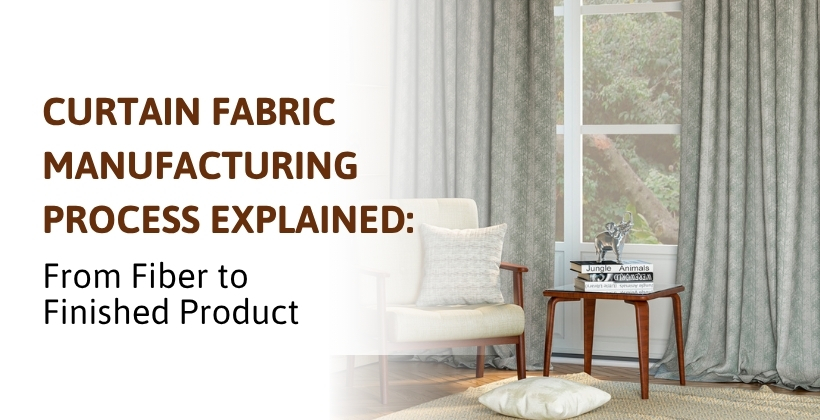Curtain Fabric Manufacturing Process Explained: From Fiber to Finished Product

For interior designers, architects, and wholesale buyers, understanding how curtain fabric is manufactured is essential for making informed decisions about quality, texture, and longevity.
In this blog, we’ll take you through the curtain fabric manufacturing process—from raw fiber selection to the final finish that makes it trend-ready.
- Fiber Selection: The Foundation of Quality:
Every curtain fabric begins with its most basic component: the fiber. The type of fiber used determines the texture, durability, sheen, and even the cost of the final fabric.
Commonly Used Fibers:- Cotton: Lightweight, breathable, and eco-friendly.
- Polyester: Durable, wrinkle-resistant, and easy to maintain.
- Linen: Elegant and natural, but prone to creasing.
- Silk: Luxurious and shiny, but more delicate.
- Blends: Combine the advantages of two or more fibers (e.g., cotton-polyester).
Fiber selection is influenced by the intended use of the curtain fabric—whether it’s decorative, functional, or both. For instance, blackout curtains often use polyester blends for their opacity and strength, while sheer curtains may use fine cotton or synthetic voile.
- Spinning: Turning Fibers into Yarn:
Once fibers are selected and cleaned, they undergo spinning, where they are twisted into yarn. Yarn thickness, strength, and twist levels directly affect how the final curtain fabric looks and feels.
Yarns can be:- Single-ply or multi-ply: For varied strength.
- Textured or smooth: To add depth or create a sleek finish.
- Dyed or undyed: Depending on whether color is added before or after weaving.
High-quality curtain fabric often uses pre-dyed yarns, as this ensures more uniform and lasting color throughout the fabric.
- Weaving: Crafting the Fabric Structure:
The yarn is then woven into curtain fabric using different techniques. The weaving pattern determines the fabric’s weight, density, and texture.
Popular Weaving Techniques:- Plain weave: Simple and durable.
- Twill weave: Creates diagonal lines; strong and drapes well.
- Jacquard weave: Used for intricate patterns and textures.
- Dobby weave: Offers small geometric patterns, often used in premium furnishings.
Manufacturers often use Jacquard looms for their curtain fabric collections, allowing them to create complex designs that are visually rich and highly customizable.
- Dyeing and Printing: Adding Color and Personality:
Once the base curtain fabric is woven, it’s time to add color and design using dyeing or printing techniques.- Dyeing: Immerses fabric in a dye solution to create solid colors.
- Printing: Applies patterns and designs using rotary, screen, or digital printing.
Digital printing has transformed the design capabilities of curtain fabric manufacturers. It allows for vibrant, photo-realistic designs and is perfect for bespoke interior projects or seasonal collections.
- Finishing: Enhancing Look and Function:
Finishing treatments improve the performance and appearance of the curtain fabric.
Common Finishes Include:- Softening agents for a better drape.
- Fire-retardant treatments for commercial use.
- Water-repellent finishes for kitchens and bathrooms.
- UV-protective coatings to resist fading from sunlight.
Processes like calendaring (pressing with heat) give curtain fabric a smooth, glossy finish, often used in formal or luxury interiors.
- Quality Control and Testing:
Before being rolled out to the market, curtain fabric goes through several quality control checks, including:- Color fastness
- Tensile strength
- Shrinkage and wrinkle resistance
- Durability under different lighting and environmental conditions
These checks ensure the fabric performs well across various applications, from residential drapes to hotel and office interiors.
Customization:
The curtain fabric industry isn’t just about function—staying on trend is equally important. Manufacturers often work with interior designers and trend experts to create seasonal collections featuring:
- Nature-inspired and geometric patterns
- Soft neutral tones or bold contrasts
- Sustainable materials and finishes
Many also offer custom weaving services, enabling architects and large-volume buyers to create exclusive designs that align with their brand or project vision.
Bringing It All Together: From Fiber to Finished Product
The journey of curtain fabric from raw fiber to a trendy, functional home essential is an intricate blend of engineering, aesthetics, and innovation. With today’s consumer demanding not only beauty but also sustainability, durability, and performance, manufacturers are innovating at every stage—from fiber sourcing to the final finishing process.
Explore Premium Curtain Fabric Collections by Batavia Exim
If you are looking for high-quality wholesale curtain fabric, it’s essential to choose a manufacturer that blends innovation with craftsmanship. Batavia Exim is a trusted curtain fabric manufacturer known for its designer collections and superior quality.
One of their standout offerings, the Shades 2 Collection, features a curated range of elegant textures, contemporary patterns, and versatile color palettes—ideal for upscale residential and commercial interiors. These fabrics are crafted using advanced weaving techniques, premium yarns, and stylish finishes to meet the evolving needs of designers, architects, and retailers.
Many Wholesalers and distributors across India source their fabrics directly from Batavia Exim, ensuring access to trend-forward, premium-grade curtain fabric at scale.
From design inspiration to bulk supply, Batavia Exim is the creative force behind the curtain fabrics that wholesalers trust and interiors demand. Discover the difference that a leading manufacturer makes in the world of wholesale curtain fabric.
Newsletter
Subscribe our Newsletter for new blog posts, tips & new photos. Let’s stay updated!
